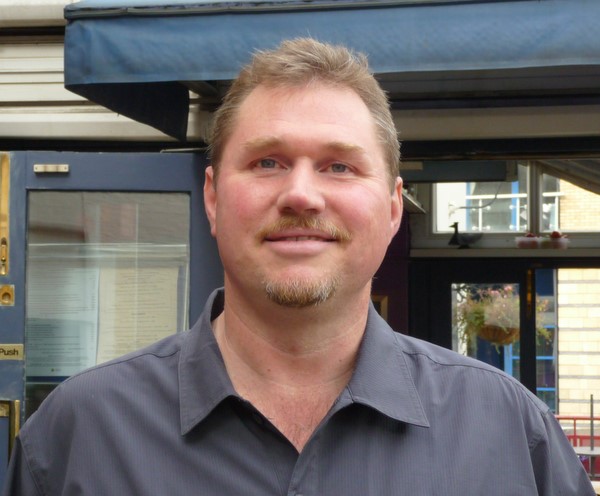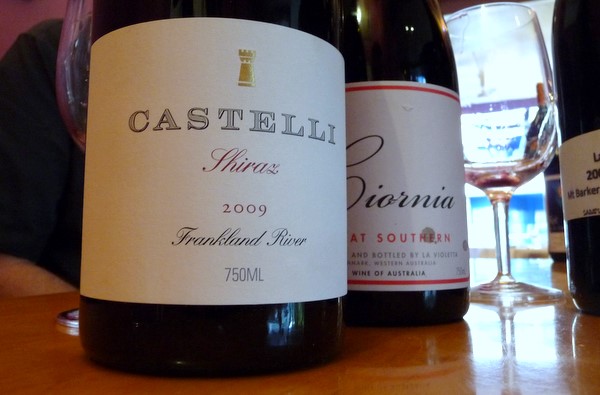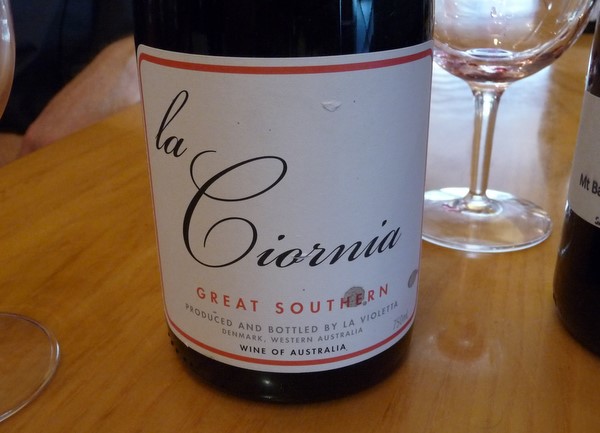|
Andrew
Hoadley: La Violetta and Castelli
Interview with an emerging star from Western Australia

Andrew
Hoadley isn’t one of Australia’s best known winemakers, but I
reckon in a few years he’ll be getting a lot more recognition for
his elegant, stylish Western Australian wines. He’s a
representative of the new face of the Australian wine industry,
which has recently seen the flourishing of small, quality minded
wineries, making fine wines aiming at precision and elegance rather
than just power.
I met
with him in London to taste through some of his wines at Ransome’s
Dock restaurant. I’d walked through Battersea Park on my way to
the restaurant when a mini pulled up alongside me. It was Andrew and
his importer Brian Oakwell, and they offered me a lift. They’re
both quite big guys, and I’m not small, so together with the wine
for the tasting, the mini ended up comically overloaded.
Andrew
didn’t take the conventional route into wine. His interest in the
subject started when he was backpacking through France and turned
his hand to some grape picking. His first port of call was
Beaucastel, but they didn’t hire Aussies, but he struck lucky in
Beaujolais and then Puligny Montrachet. ‘In that six week period I
got to enjoy good French wine,’ he recalls.
Then,
a few years later he decided to go down to the Yarra and get a job
with De Bortoli, where he did a traineeship in viticulture, and this
was followed by spells with De Bortoli’d Griffith outpost, and
Hardy’s in Canberra District. It was in Canberra that Andrew went
through a pivotal stage in his wine journey: he met Alex McKay of
Collector Wines (www.collectorwines.com.au),
a tiny boutique winery making highly rated Shiraz. ‘Alex is a
Barolo fanatic, and he got me into Italian wines,’ says Andrew.
‘So I went to Piedmont and did a vintage there, and started to get
an idea about the wine styles I wanted to make.’

After this he worked in Tasmania with
Hardys, and the Strathbogie Ranges with Dominion Wines. A change in
ownership there saw Andrew out of a job, forcing him to head off to
the high-producing, more commercial Riverland region in South
Australia to make wine, which he surprisingly describes as a good
experience. ‘All my background had been cool climate till then,
but this stop-gap helped me polish the technical side of winemaking,
giving me an idea of systems and process flow.’
Two further vintages in Barbaresco (Pidemont),
confirmed Andrew’s love for Italian wine. He has been back three
times since. ‘I turned up in Barolo two days before a big
hailstorm,’ he recalls, ‘and ended up knocking on doors,’ He
struck lucky and got a gig with Renato Vacca at Cantina del Pino (www.cantinadelpino.com).
‘We really connected. There was a good scene around there and I
felt really welcome,’ says Andrew. ‘It was an exciting place to
make wine, with people debating traditional versus traditional
styles. There was a lively exchange of ideas.’
‘To that point, I probably had quite an
Australian palate,’ he states. ‘In Australia there tends to be a
focus on maximum extraction, with lots of fruit weight. If you have
lots of fruit layered with tannins and oak, it’s a limited
approach to wine styles.’ He does qualify this by saying that this
was the attitude in the early 1990s, and that things are (sort of)
changing in Australia. ‘There seem to be a lot of people now doing
small production, pushing the boundaries, but the Australian style
is still at the centre, and wine shows tend to perpetuate that.’
So
how did he end up in Western Australia? Andrew was working in
Abruzzo in Italy when he got a call from a friend telling him about
a job with Castelli in Denmark, Western Australia. He wasn’t sure
at first because he didn’t know the Western Australian wine scene,
but soon realised that this was a glorious part of the world with
interesting, relatively unknown regions around Denmark, including
Pemberton, Frankland, Mount Barker and Kalgan River.
So he
went to work for Castelli. The Castelli approach is to strike up
arrangements with good vineyards, and Larry Cherubino is involved in
helping source grapes in a consultancy role. ‘Larry knows the
western Australia vineyards very well, sourcing top fruit for us,’
says Andrew. The winemaking is left up to Andrew and the other
winemaker here, Mike Garland. ‘It’s a luxury for a winery of
this size to have two winemakers.’ As well as making the Castelli
wines, Mike and Andrew also do quite a bit of contract work (it’s
a 750 ton winery, and Castelli’s production is from 50 tons), and
Andrew tasted the Kalgan River Shiraz 2007 from barrel, made under
contract here, and was smitten. Part of the arrangement is that he
is able to do his own small project at the winery, which is where
the La Violetta wines come in, and Andrew managed to get some of the
grapes from the Kalgan River vineyard to make his La Ciorna
bottling.

His
winemaking touch, with both the Castelli and La Violetta wines, is
assured. I was particularly impressed with the two La Violetta
wines, which are simply world class. ‘I’ve had some luck to get
these vineyards,’ says Andrew. ‘Things just fell into the right
place at the right time and to have Castelli’s winery—modern and
set up for small batch winemaking—has been a great bit of
fortune.’
THE
WINES
Castelli
Riesling 2010 Porongurup, Western Australia
Very tight, crisp and mineral with a floral, limey quality to
the nose. The palate has a lovely precise, fresh, delicate fruit,
showing lemons and herbs with a touch of fruit sweetness. Dry,
mineralic finish. 90/100
Castelli
Pinot Noir 2009 Denmark/Frankland River
Half the fruit comes from Denmark, half from the Rocky Gully
vineyard in the Frankland River, with just 50 cases made. Sweet,
fresh, aromatic bright cherry and berry fruit nose, with hints of
chocolate and spice. The palate shows lovely bright vivid cherry and
berry fruit with a tangy edge. Sweetly fruited and berryish, this
has a bit of bite on the finish. 89/100
Castelli
Cabernet Sauvignon 2009 Margaret River
Very fresh, bright aromatic berry and blackcurrant fruit nose
with a gravelly edge. Fresh and pure. The palate shows lovely
freshness and has a gravelly grip. Lovely definition and structure
here. A superb effort. 93/100
Castelli
Shiraz 2009 Frankland River
From the Hadley Hall vineyard. Lovely sweet, ripe spicy, meaty
nose with a nicely savoury edge to the focused black fruits. The
palate has very nicely judged ripe berry fruits with some dark
cherry overtones meshing well with the spicy oak. Lovely focus to
this linear wine, which I think will age beautifully. 91/100
La
Violetta ‘Up’ Shiraz 2008 Mount Barker
From a 28 year old vineyard, this has firmer tannins than La
Ciorna. Very aromatic with bright, sweet, focused fruit – mainly
blackberry and raspberry with hints of medicine and meat in the
background. The palate has lovely freshness, combining very ripe
fruit with firm tannins and good acidity, together with some olive
notes. Gutsy and fresh. 92/100
La
Violetta La Ciorna 2008 Great Southern
From the Kalgan River vineyard. Really refined bright, aromatic
nose showing sweet, pure raspberry and cherry fruit with subtle
hints of meat, olive and spice. The palate is superbly elegant with
pure, seamless, beautifully poised cherry and raspberry fruit.
Lovely elegance and freshness here: this is so elegant with real
balance. 94/100
See
also:
 Landmark
Australia (series) Landmark
Australia (series)
Wines
tasted 08/10
Find these wines with wine-searcher.com
Back
to top
|

